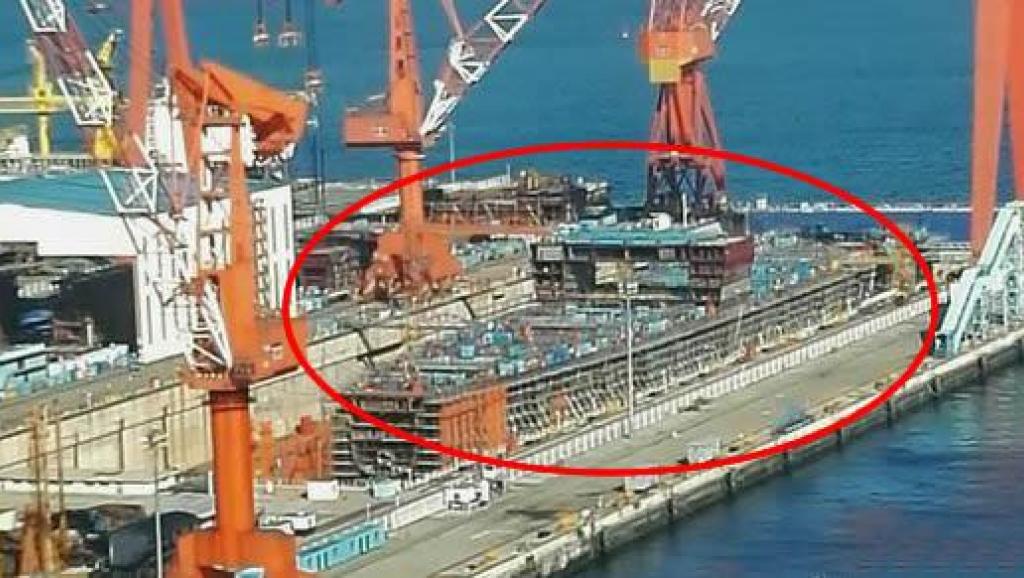From official source.
Advantages of China's first domestically-built aircraft carrier, compared to "Liaoning"
Source
China Military Online
Editor Yao Jianing
Time 2018-03-02
BEIJING, March 2 (ChinaMil) -- China's first domestically-builtaircraft carrierhas attracted worldwide attention since it was launched on Apr. 26, 2017. The new vessel is similar to the aircraft carrier Liaoning, which was commissioned to the PLA Navy on Sept. 25, 2012, but has major technical improvements.
Many netizens have called China's first domestically-built aircraft carrier a "pirated version" of the aircraft carrier Liaoning. In fact, it has had a comprehensive technical upgrading based on the Liaoning ship and
the biggest difference between the two is in function and task.
Aircraft carrier Liaoning’s function is positioned as an aircraft carrier research and training platform. Its main task is to complete a large number of scientific experiments relevant to aircraft carriers and carrier-based fighter jets, as well as pilot selection and training. Aircraft carrier Liaoning has now formed a maritime formation combat capability after more than five years' practical research.
However, China's first domestically-built aircraft carrier, from the very beginning, was positioned as a large carrier combat platform. It is a new starting point for the construction of an integrated combat capability of the Chinese PLA Navy. Due to its nature as a large-scale maritime combat platform, with aircraft as its main weapon, the first domestically-built carrier is described as a "sea-going airport."
Optimization of performance
The full displacement of the new carrier is thousands of tons larger than that of Liaoning ship. It still has a ski-jump flight deck design, with a technical upgrade to the angle of the upturned deck.
The angle of the upturned deck of
Liaoning ship is about 14 degrees and that of
the new domestically-built vessel is 12 degrees. The main basis for this major technological improvement comes from a large amount of flight test data accumulated by Liaoning ship and its J-15 fighters.
The compatibility of the new aircraft carrier and the J -15 fighter jet is more optimized compared with Liaoning ship. This gives full play to the maximum operational effectiveness of the J-15.
Optimization of structure
In terms of structural design, China's first domestically-built aircraft carrier fully meets current aircraft carrier standards. These differ from the design concept and operational use of the carriers (heavy aviation cruisers) of the Soviet Union.
Liaoning ship's predecessor was the unfinished Varyag, which is the sister ship of the Russian Navy's only aircraft carrier, the Admiral Kuznets. Varyag was the No.2 aircraft carrier of the Soviet Union's third-generation heavy aviation cruiser class.
The Kuznets class aircraft carrier is equipped with a large number of carrier-based missile weapon systems including large-scale long-range anti-ship, ship-to-air missile launchers hidden under the flight deck. During the restoration and reconstruction of Liaoning ship, those weapon systems were dismantled.
The large-scale long-range missile launchers hidden under the flight deck inevitably have a great impact on the operation of carrier-based aircraft. The flight deck needs to be emptied before the missile launchers can be turned on, and as a result, carrier-based aircraft cannot take off.
The Russian long-range anti-ship missiles are bulky and they are vertically mounted below the flight deck. That design occupies a large interior space and has a negative impact on the hull structural design.
A standard aircraft carrier's main weapon is the fighter jet. The space under the flight deck is the hangar used for aircraft storage, maintenance and repair. The design of China's first domestically-built aircraft carrier abandons the anti-ship missile launchers and therefore its hangar is larger and can store more jets.
Stunning information capacity
As a large maritime mobile airport, the aircraft carrier must effectively combine the operation of various types of carrier-based aircraft with the requirements of navigation. For this reason, various advanced electronic information devices and capabilities are required.
Despite the larger size of aircraft carrier, the installation of this electronic information equipment in a limited space is also a huge technical challenge due to their large number and variety of types.
The carrier-based electronic equipment includes a combat commanding system and navigation, avionics and other information systems. China's first domestically-built aircraft carrier has new improvements based on the trials by Liaoning ship.
For example,
the improved large-scale active phased array radars installed above the starboard ship island is far superior to its Russia counterpart in terms of overall performance, air-to-air detection range and detecting capability of airborne targets. This will help enhance the air defense capability of the aircraft carrier and its formation.
At present, China's first domestically-built aircraft carrier is being outfitted. As the number of scaffoldings on the ship declines, the trial trip date gradually approaches.
Based on the considerable amount of experience in Liaoning ship, the first domestically-built aircraft carrier will become the second aircraft carrier of the Chinese PLA Navy in a few years. China's blue-water navy goal is gradually becoming a reality.
The author is Li Wen, reporter with the China Youth Daily.










